Solar eclipse of March 9, 1997
A total solar eclipse occurred on March 9, 1997. A solar eclipse occurs when the Moon passes between Earth and the Sun, thereby totally or partly obscuring the image of the Sun for a viewer on Earth. A total solar eclipse occurs when the Moon's apparent diameter is larger than the Sun's, blocking all direct sunlight, turning day into darkness. Totality occurs in a narrow path across Earth's surface, with the partial solar eclipse visible over a surrounding region thousands of kilometres wide. Totality was visible in eastern tip of Kazakhstan, northern tip of Xinjiang and Northeastern China, Northern Mongolia and Russia.
| Solar eclipse of March 9, 1997 | |
|---|---|
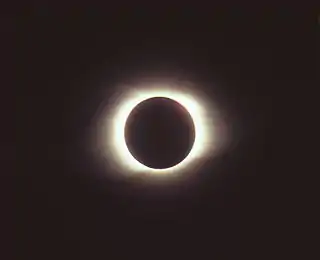 Total eclipse from Chita, Russia | |
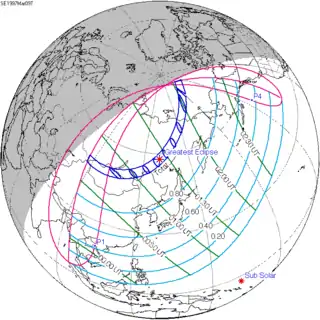 Map | |
| Type of eclipse | |
| Nature | Total |
| Gamma | 0.9183 |
| Magnitude | 1.042 |
| Maximum eclipse | |
| Duration | 170 sec (2 m 50 s) |
| Coordinates | 57.8°N 130.7°E |
| Max. width of band | 356 km (221 mi) |
| Times (UTC) | |
| Greatest eclipse | 1:24:51 |
| References | |
| Saros | 120 (60 of 71) |
| Catalog # (SE5000) | 9501 |
Unusual gravity variations
This solar eclipse is somewhat special in the sense that some unexplained gravity anomalies of about 7 10−8 m/s2 during the solar eclipse were observed. Attempts (e.g., Van Flandern–Yang hypothesis) to explain these anomalies have not been able to reach a definite conclusion.[1]
Images
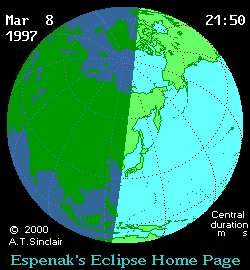
Related eclipses
Eclipses of 1997
Solar eclipses 1997–2000
This eclipse is a member of a semester series. An eclipse in a semester series of solar eclipses repeats approximately every 177 days and 4 hours (a semester) at alternating nodes of the Moon's orbit.[2]
| Solar eclipse series sets from 1997–2000 | ||||||
|---|---|---|---|---|---|---|
| Descending node | Ascending node | |||||
| Saros | Map | Gamma | Saros | Map | Gamma | |
120 Chita, Russia | 1997 March 9 Total | 0.91830 | 125 | 1997 September 2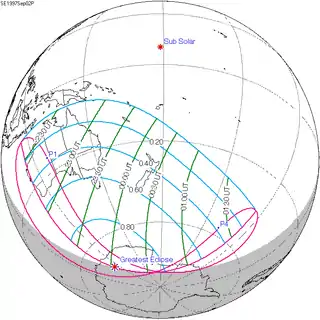 Partial | -1.03521 | |
130.jpg.webp) Total eclipse near Guadelope | 1998 February 26 Total | 0.23909 | 135 | 1998 August 22 Annular | -0.26441 | |
| 140 | 1999 February 16 Annular | -0.47260 | 145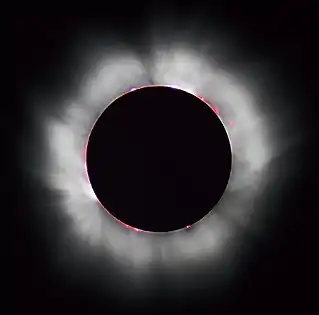 Totality from France | 1999 August 11 Total | 0.50623 | |
| 150 | 2000 February 5 Partial | -1.22325 | 155 | 2000 July 31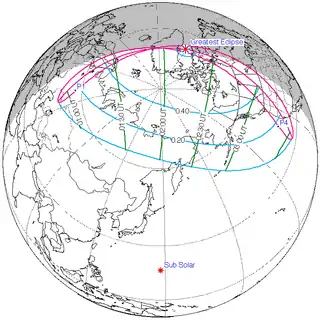 Partial | 1.21664 | |
| Partial solar eclipses on July 1, 2000 and December 25, 2000 occur in the next lunar year eclipse set. | ||||||
Saros 120
This eclipse is a part of Saros cycle 120, repeating every 18 years, 11 days, containing 71 events. The series started with partial solar eclipse on May 27, 933 AD, and reached an annular eclipse on August 11, 1059. It was a hybrid event for 3 dates: May 8, 1510, through May 29, 1546, and total eclipses from June 8, 1564, through March 30, 2033. The series ends at member 71 as a partial eclipse on July 7, 2195. The longest duration of totality was 2 minutes, 50 seconds on March 9, 1997. All eclipses in this series occurs at the Moon’s descending node.
| Series members 55–65 occur between 1901 and 2100 | ||
|---|---|---|
| 55 | 56 | 57 |
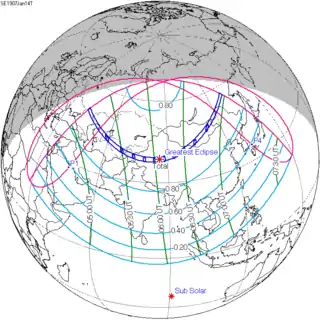 January 14, 1907 |
 January 24, 1925 |
 February 4, 1943 |
| 58 | 59 | 60 |
 February 15, 1961 |
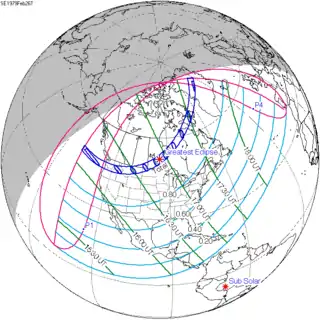 February 26, 1979 |
 March 9, 1997 |
| 61 | 62 | 63 |
 March 20, 2015 |
 March 30, 2033 |
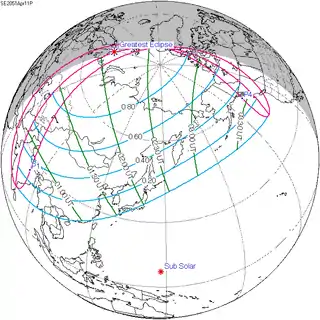 April 11, 2051 |
| 64 | 65 | |
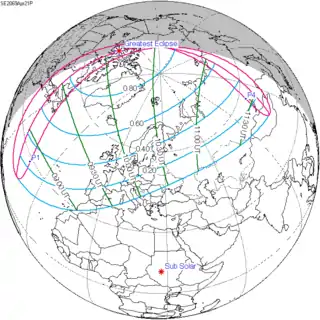 April 21, 2069 |
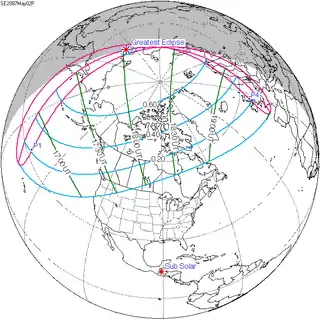 May 2, 2087 | |
Metonic series
The metonic series repeats eclipses every 19 years (6939.69 days), lasting about 5 cycles. Eclipses occur in nearly the same calendar date. In addition, the octon subseries repeats 1/5 of that or every 3.8 years (1387.94 days). All eclipses in this table occur at the Moon's descending node.[3]
| Octon series with 21 events between May 21, 1993 and August 2, 2065 | ||||
|---|---|---|---|---|
| May 20–21 | March 8–9 | December 25–26 | October 13–14 | August 1–2 |
| 98 | 100 | 102 | 104 | 106 |
| May 21, 1955 | March 9, 1959 | December 26, 1962 | October 14, 1966 | August 2, 1970 |
| 108 | 110 | 112 | 114 | 116 |
| May 21, 1974 | March 9, 1978 | December 26, 1981 | October 14, 1985 | August 1, 1989 |
| 118 | 120 | 122 | 124 | 126 |
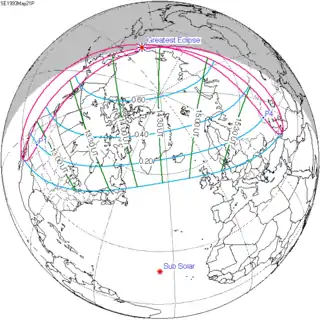 May 21, 1993 |
 March 9, 1997 |
 December 25, 2000 |
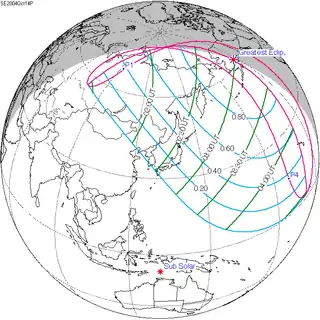 October 14, 2004 |
 August 1, 2008 |
| 128 | 130 | 132 | 134 | 136 |
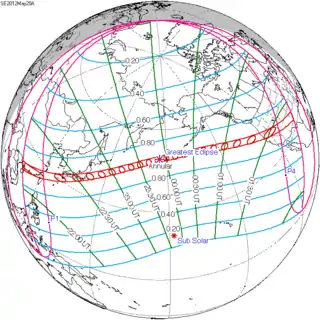 May 20, 2012 |
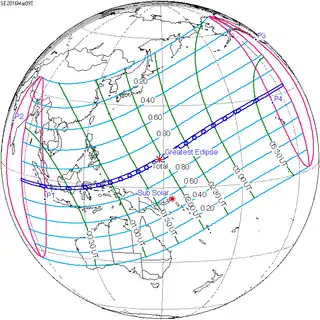 March 9, 2016 |
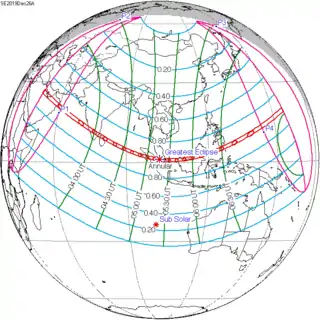 December 26, 2019 |
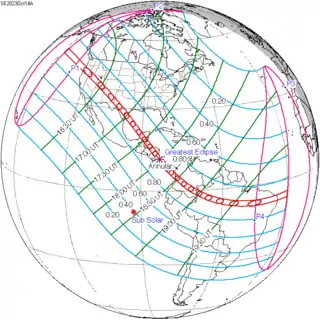 October 14, 2023 |
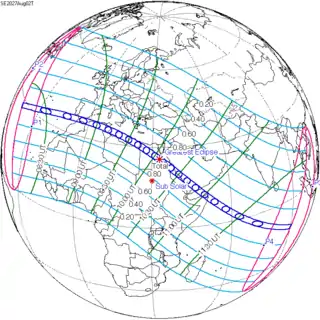 August 2, 2027 |
| 138 | 140 | 142 | 144 | 146 |
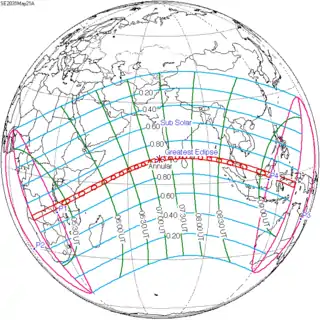 May 21, 2031 |
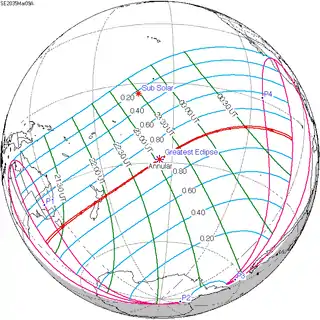 March 9, 2035 |
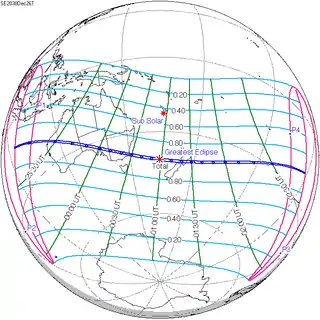 December 26, 2038 |
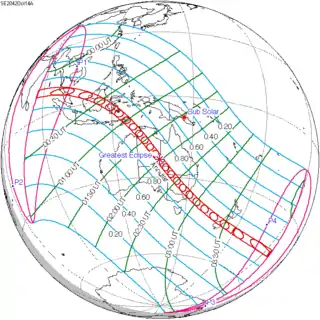 October 14, 2042 |
 August 2, 2046 |
| 148 | 150 | 152 | 154 | 156 |
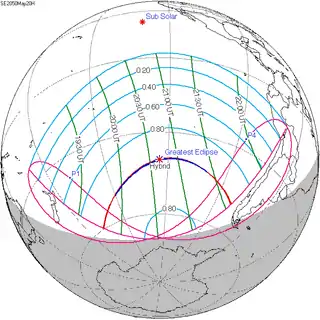 May 20, 2050 |
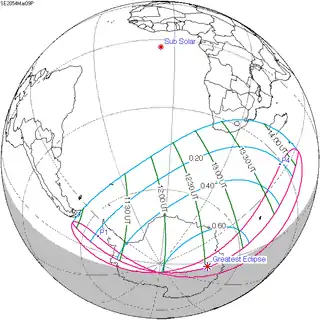 March 9, 2054 |
 December 26, 2057 |
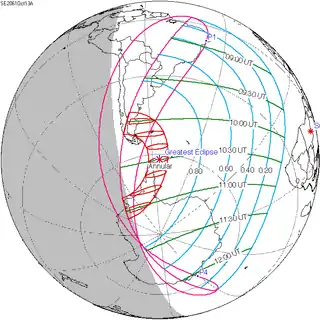 October 13, 2061 |
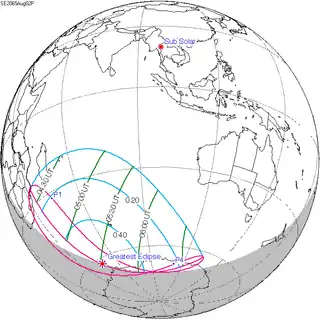 August 2, 2065 |
| 158 | 160 | 162 | 164 | 166 |
 May 20, 2069 |
March 8, 2073 | December 26, 2076 | October 13, 2080 | August 1, 2084 |
See also
References
- Wang, Qian-shen; Yang, Xin-she; Wu, Chuan-zhen; Guo, Hong-gang; Liu, Hong-chen; Hua, Chang-chai (2000-07-14). "Precise measurement of gravity variations during a total solar eclipse". Physical Review D. American Physical Society (APS). 62 (4): 041101(R). arXiv:1003.4947. doi:10.1103/physrevd.62.041101. ISSN 0556-2821.
- van Gent, R.H. "Solar- and Lunar-Eclipse Predictions from Antiquity to the Present". A Catalogue of Eclipse Cycles. Utrecht University. Retrieved 6 October 2018.
- Freeth, Tony. "Note S1: Eclipses & Predictions". plos.org. Retrieved 6 October 2018.
External links
- Earth visibility chart and eclipse statistics Eclipse Predictions by Fred Espenak, NASA/GSFC
Photos:
| Wikimedia Commons has media related to Solar eclipse of 1997 March 9. |
.jpg.webp)

